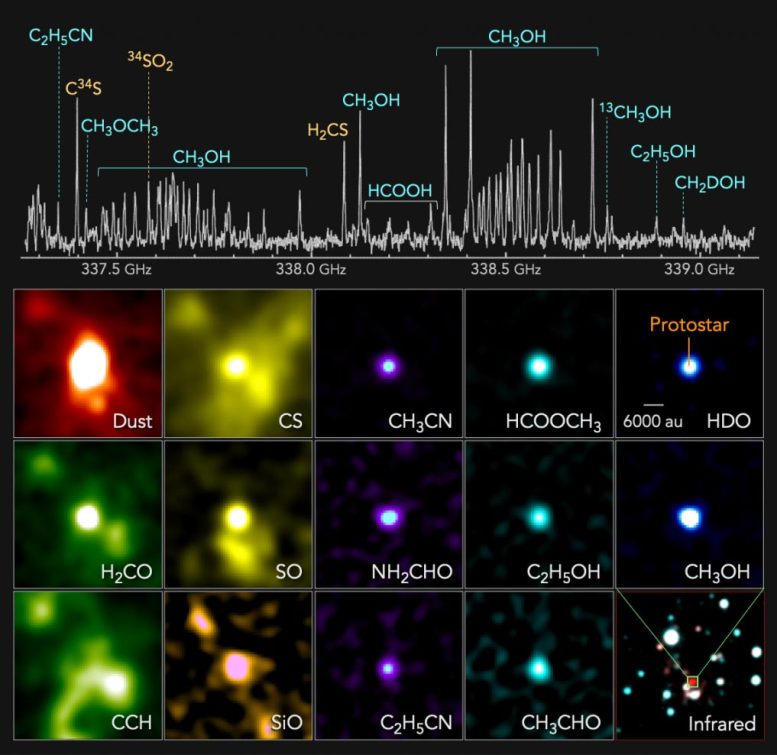
Artist’s conceptual image of the protostar discovered in the extreme outer Galaxy. Credit: Niigata University
For the first time, astronomers have detected a newborn star and the surrounding cocoon of complex organic molecules at the edge of our Galaxy, which is known as the extreme outer Galaxy. The discovery, which revealed the hidden chemical complexity of our Universe, appears in a paper in The Astrophysical Journal.
The scientists from Niigata University (Japan), Academia Sinica Institute of Astronomy and Astrophysics (Taiwan), and the National Astronomical Observatory of Japan, used the Atacama Large Millimeter/submillimeter Array (ALMA) in Chile to observe a newborn star (protostar) in the WB89-789 region, located in the extreme outer Galaxy.
A variety of carbon-, oxygen-, nitrogen-, sulfur-, and silicon-bearing molecules, including complex organic molecules containing up to nine atoms, were detected. Such a protostar, as well as the associated cocoon of chemically-rich molecular gas, were for the first time detected at the edge of our Galaxy.
The ALMA observations reveal that various kinds of complex organic molecules, such as methanol (CH3OH), ethanol (C2H5OH), methyl formate (HCOOCH3), dimethyl ether (CH3OCH3), formamide (NH2CHO), propanenitrile (C2H5CN), etc., are present even in the primordial environment of the extreme outer Galaxy. Such complex organic molecules potentially act as the feedstock for larger prebiotic molecules.

Top: Radio spectrum of a protostar in the extreme outer Galaxy discovered with ALMA. Bottom: Distributions of radio emissions from the protostar. Emissions from dust, formaldehyde (H2CO), ethynylradical (CCH), carbon monosulfide (CS), sulfur monoxide (SO), silicon monoxide (SiO), acetonitrile (CH3CN), formamide (NH2CHO), propanenitrile (C2H5CN), methyl formate (HCOOCH3), ethanol (C2H5OH), acetaldehyde (CH3CHO), deuterated water (HDO), and methanol (CH3OH) are shown as examples. In the bottom right panel, an infrared 2-color composite image of the surrounding region is shown (red: 2.16 μm and blue: 1.25 μm, based on 2MASS data). Credit: ALMA (ESO/NAOJ/NRAO), T. Shimonishi (Niigata University)
The ALMA observations reveal that various kinds of complex organic molecules, such as methanol (CH3OH), ethanol (C2H5OH), methyl formate (HCOOCH3), dimethyl ether (CH3OCH3), formamide (NH2CHO), propanenitrile (C2H5CN), etc., are present even in the primordial environment of the extreme outer Galaxy. Such complex organic molecules potentially act as the feedstock for larger prebiotic molecules.

Top: Radio spectrum of a protostar in the extreme outer Galaxy discovered with ALMA. Bottom: Distributions of radio emissions from the protostar. Emissions from dust, formaldehyde (H2CO), ethynylradical (CCH), carbon monosulfide (CS), sulfur monoxide (SO), silicon monoxide (SiO), acetonitrile (CH3CN), formamide (NH2CHO), propanenitrile (C2H5CN), methyl formate (HCOOCH3), ethanol (C2H5OH), acetaldehyde (CH3CHO), deuterated water (HDO), and methanol (CH3OH) are shown as examples. In the bottom right panel, an infrared 2-color composite image of the surrounding region is shown (red: 2.16 μm and blue: 1.25 μm, based on 2MASS data). Credit: ALMA (ESO/NAOJ/NRAO), T. Shimonishi (Niigata University)